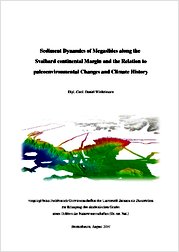| dc.contributor.author | Winkelmann, Daniel | |
| dc.date.accessioned | 2010-10-12T19:28:38Z | |
| dc.date.available | 2010-10-12T19:28:38Z | |
| dc.date.issued | 2007 | |
| dc.identifier.uri | http://hdl.handle.net/11858/00-1735-0000-0001-31C2-C | |
| dc.description.abstract | Slope stability, submarine slides, Svalbard, Arctic Ocean, Sophia Basin. - With increasing interest in slope stability issues on continental shelves the causes and trigger mechanism of submarine slides get more and more into the scientific focus. Within the ESF EUROMARGINS project 'Slope Stabilities on Europe's passive continental Margin' (SPACOMA) sediment dynamics of megaslides along the passive continental margin north of Svalbard have been investigated. The study concentrated on identification and sedimentological characterisation of megafailure events, their dating and interpretation in relation to paleoceanography and climate history of the Svalbard archipelago. Integrated interpretation of multibeam bathymetric, sediment-penetrating acoustic (PARASOUND) and seismic data shows a multiple slope failure on the northern European continental margin, north of Spitsbergen. One huge submarine slide has been identified which was first described by Cherkis et al. (1999) - the Yermak Slide (later named Hinlopen/Yermak Megaslide). The extent of the Hinlopen/Yermak Megaslide has been revised based on new acoustic and detailed bathymetric data. Details from the side's internal structure give evidence for one main slide event followed by repeated minor events. The first slide event occurred during MIS 3 around 30 cal. kyr. BP and was characterised by highly dynamic and rapid evacuation of ca. 1.250 kmÃÂđ of sediment from the lower to the upper part of the shelf slope. During this megaslide event, headwalls up to 1600 m have been created and ca. 1150 kmÃÂđ material from hemipelagic sediments and from the lower preexisting trough mouth fan has been entrained and transported into the semi-enclosed Sophia Basin. This megaslide was followed by a secondary evacuation of debris material to the Nansen Basin accomplished by funnelling of the debris through the Littke Channel between Polarstern Seamount and the adjacent continental slope. The main slide debris is overlain by a set of fining-upwards sequences as evidence for the associated suspension cloud and ... | |
| dc.format.mimetype | application/pdf | |
| dc.language.iso | eng | |
| dc.publisher | Univ. Bremen | |
| dc.rights.uri | http://e-docs.geo-leo.de/rights | |
| dc.subject.ddc | 551.307 | |
| dc.subject.ddc | 551.69 | |
| dc.subject.ddc | 551 | |
| dc.title | Sediment dynamics of megaslides along the Svalbard continental margin and the relation to paleoenvironmental changes and climate history | |
| dc.type | monograph | |
| dc.subject.gokverbal | Nordatlantische Polarinseln {Geologie} | |
| dc.subject.gokverbal | Sedimente bestimmter Regionen | |
| dc.subject.gokverbal | Sonstige Sedimentationsprozesse | |
| dc.subject.gokverbal | Paläoklimatologie | |
| dc.identifier.doi | 10.23689/fidgeo-311 | |
| dc.identifier.ppn | 557824680 | |
| dc.type.version | publishedVersion | |
| dc.relation.collection | Geophysik | |
| dc.description.type | thesis | |


